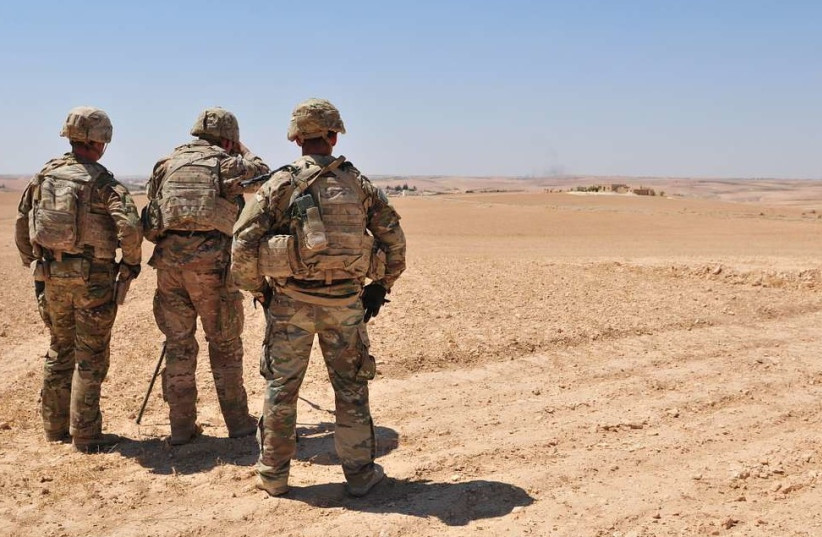Phased US pullout from Syria raises concerns for Israel
Reports this week indicate that the US may be withdrawing its forces from Syria in a phased plan that could take months. This was expected, but it also comes as a surprise. The first Trump administration also attempted to withdraw US forces in 2018 and 2019. In both cases, the overall withdrawal did not take place. It’s possible that this time, US forces may redeploy but not withdraw completely.
Israel has often viewed the potential US withdrawal as a challenge. During the first Trump administration, the concern was that Iran-backed militias would fill the vacuum left by the US. It’s important to understand the geography here. The US-backed Syrian Democratic Forces control eastern Syria.
Essentially, they control a third of Syria east of the Euphrates River. They ended up on the river during the ISIS war because the last ISIS cells were in an area called Baghuz on the Euphrates River near the Iraqi border. The US sent forces to Syria to help the SDF fight ISIS. The SDF is primarily made up of Kurdish fighters, with some Arab contingents and also Christian fighters.
Turkey opposes the SDF and views it as part of the Kurdistan Workers Party, or PKK. Turkey has sent forces to fight the SDF. When the US withdrew from a few areas around Serekaniye in 2019 near the Turkish border, Turkey bombed the SDF and invaded. Ankara backed Syrian proxies called the Syrian National Army to attack the SDF. This put the US in an awkward position of backing the SDF and having the SDF bombed by a member of NATO. In essence, a US ally was bombing a US partner force.
During the period 2018 and 2019, the big concern was that Iran would move into eastern Syria and threaten Israel. US forces are also at Tanf in southern Syria near the Iraq and Jordanian border. The US 10th Mountain Division has elements at Tanf backing a small Arab force called the Syrian Free Army.

The Tanf area sits in a strategic site because it sits near the Iraq and Jordanian border, and in the days before the fall of the Assad regime, this area could keep watch on Iranian-backed activity. The US forces are in Syria to help fight ISIS. They are not there to watch Iran or Iranian-backed militias. However, their mere presence helped to warn off Iran and also Russia, which had forces in Syria.
From Israel’s point of view, the US role in Syria was helpful because it created an area of influence that was free of Iran’s nefarious role. However, when the Assad regime fell, the Iranian-backed militias left Syria. Iran’s road to the sea to back Hezbollah via Syria was broken. Israel, however, views the new Syrian government with suspicion, and Israel has carried out large numbers of airstrikes in Syria ostensibly to deny the new government access to former Assad regime military hardware.
If the US leaves Syria today or withdraws in stages, then the areas will be backfilled by the new Syrian government. The new government signed a deal with SDF commander Mazloum Abdi on March 10. The SDF is supposed to integrate into the new Syrian government’s security forces over the next year. This gives the Syrian government a potential new major US-trained force of some 50,000 men. The US backed the Abdi meeting with Syria’s president, Ahmed al-Sharaa, on March 10. It also backed a deal over the Tishreen dam in central Syria on the Euphrates, where the SDF is handing over the dam to Damascus. This is important, and it shows the US can pave the way for the next stage.
Problematic power vacuum
However, Israel is likely concerned that any power vacuum could be problematic. Today, Israel appears more concerned about Turkey’s role in Syria than Iran. Turkey, which is often hostile to Israel, could now play the role Iran once did. However, US President Donald Trump has said he could work out a deal between Turkey and Israel.
The US was never going to stay in Syria forever. Israel has known this for the last eight years. While things have changed in Syria, it is an important country on Israel’s Golan border. It is also doing a lot of outreach in the region. Most countries in the region oppose Israel’s bombing campaign in Syria. Turkey could exploit this opposition. The question now is whether the bombing campaign might backfire as the US signals withdrawal. The US forces were never the main issue for Israel in Syria. It was the US influence and how it helped to create a counterweight to the influence of anti-Israel actors. The question now is what comes next and how the US will manage its redeployment of forces.





Comments are closed.